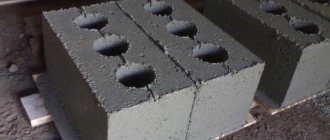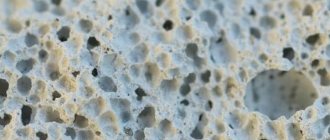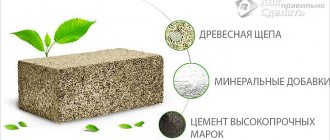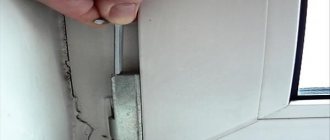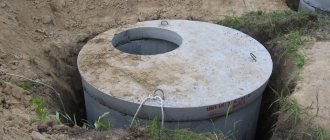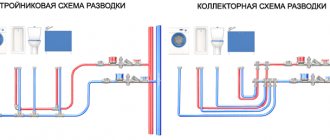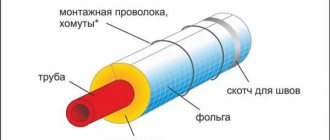0
20546
23.07.2013
Pipes usually get clogged at the most inopportune times, usually in the morning, when you are late for work, or even worse, when you need to take a bath or go to the toilet, and there is a blockage in the bathroom or kitchen. In this article we will look at the main effective ways to quickly clean sewer pipes without much effort.
Severe blockage in the sewer pipe
How to find out what exactly is clogged in a sewer pipe
Identifying the problem in a timely manner and taking quick action is our main task, which is why we will begin to act promptly and then proceed, first determine whether water is draining in other sewer units, be it a toilet, sink, bathtub or shower. If the water does not drain in any of them, then we have big problems. The fact is that in multi-storey buildings, especially on the first floors, sometimes the riser itself becomes clogged and the water not only begins not to drain, but even in rare cases rises to the top from the toilet or from the bathtub, then quickly dial the number of a plumber or housing office and call them.
It’s very easy to find out the ZHEKA number by going out into the entrance and reading the phone number on the electrical panel.
Types of blockages and their differences
Operational blockage.
This is a blockage that owes its appearance to fat. Yes, yes, grease sticks to the pipes inside, and hair and other waste begin to stick to it and accidentally fall into the sink through the drain hole.
Mechanical blockage.
A mechanical blockage occurs mainly due to the fault of the apartment tenant himself - a common example of a mechanical blockage is toilet paper, which is thrown into the toilet almost every day. Sometimes the paper is not corroded by water and a blockage forms, which can only be removed with special means that corrode the paper and accumulated debris.
Obstruction in the siphon.
A siphon is a device that you can see below in the picture; it serves as a barrier that protects us from unpleasant odors - it is a kind of filter from direct odors from the sewer. But over time, fat gets into the siphon, which in turn accumulates other deposits inside itself.
You can clean the siphon very simply - unscrew it and rinse it with hot water with the addition of FARRY or other dishwashing liquids - this will remove dirt from the inside.
Picture – sewer siphon
Technogenic blockage.
You have a new apartment, and blockages appear periodically; you don’t know how to deal with it? The answer is simple - this is the worst option of all those discussed above. It is a man-made blockage that cannot be eliminated with improvised means, because it occurs due to an error in the design of sewer systems; unfortunately, this is not uncommon.
Why do clogs form in pipes?
The first sign that a blockage has accumulated in the pipes is the slow drainage of water. The second “symptom” is an unpleasant odor that comes from the drain hole. The problem of clogged pipes arises for several reasons:
Fat blockages
Approximately 70-80% of cases are associated with this factor. Grease enters the pipes from dishwashers, washing machines and the kitchen sink. It is deposited on the pipes and forms a fatty plug over the years.
The fat accumulation is heterogeneous in texture. It is soft in inner diameter and resembles a jelly-like substance in consistency. The outer diameter of the plaque adjacent directly to the pipe is very hard. The texture becomes hard due to the reinforcement of the fat layer with various fibrous particles that end up in the drain: hair, threads after washing clothes. In addition, accumulations on pipes actively absorb mineral salts of wastewater, which makes them more compacted.
Fat clog in the pipe
Fat accumulations are the most difficult to remove. They are characterized by increased durability, and a draft in the pipes dries them and makes them even stronger.
Mechanical blockages
They occur much less frequently, in only 10-20% of cases. Mechanical blockages form if objects that should not be there get into the sewer: scraps of toilet paper, cotton pads, ear cleaning sticks, remnants of solutions used during repairs, and more.
Mechanical blockages in pipes
Kitchen waste is no less dangerous. For example, coffee grounds poured down a drain can cause clogs. The same “effect” will be had by onion peels, peels of vegetables and fruits, and leftover food that gets into the pipe. Another risk factor is small parts of children's toys and construction sets, which, due to parental oversight, may end up in the sewer pipe and form a blockage there.
Incorrect pipe installation
If the pipes are installed incorrectly, after a while, accumulations will begin to form in them.
Mechanical blockages in pipes
This can happen for a number of reasons:
- the pipes are connected at too sharp an angle;
- installation is made with an excessively small slope;
- pipes with a cross-section that are too small have been selected;
- vent pipes and valves are not installed;
- At the junction, the ends were not cleaned and burrs remained, which trap wastewater particles.
Pipes connected at right angles can also cause blockages. The same consequences will appear if the drains have too many turns and bends in a small area.
Old pipes
Another cause of blockage is pipes whose service life has expired. Even if the wiring is done correctly, but the pipes are outdated, traffic jams may appear.
Old pipes
This is especially true for cast iron pipes. Their inner surface is susceptible to corrosion. A layer of metal “eaten” by rust is ideal conditions for the accumulation of grease and dirt. PVC pipes do not have this disadvantage, therefore, practically no deposits of fatty deposits form on their surface.
Knowing what exactly caused the pollution of the drain pipes will make it much easier to get rid of the problem.
Signs of a clogged drain
Before you think about how to clean the sewer, you need to identify the causes of the blockage and the place of its formation.
Obstacles to the normal drainage of water can form in the form of accumulation of lime, grease or inorganic objects (paper, rags). Signs of clog formation will help you deal with the problem. Thus, the need to take measures to clean pipes is confirmed by the following signs:
- unpleasant odor detected in the area of drain holes in the bathroom or kitchen;
- water flows out of the sink or bathtub at a lower rate than before;
- The water level when flushing the toilet tank is higher than normal.
If at least one sign is detected, action should be taken. Clogged sewer pipes occur for the following reasons:
- fat frozen on the inner walls of the pipes narrows the working diameter. Residues of food, hair, and debris stick to the fatty layer, resulting in the passage being completely clogged;
- settling of solid inorganic sediments inside the pipe. Often such blockages appear in places where the installation height of pipes in transition bends changes;
- In addition to grease, soap solution or remnants of washing powder from the machine may settle on the inner walls. Together with food waste, soap lingers on the inner surface, forming a plug;
- severe contamination is formed by the interaction of fatty accumulations inside the pipes and hair or animal hair that gets into the drain holes. Such blockages can only be removed using chemicals or mechanical action;
- violations in the installation of sewer pipes in an apartment or autonomous system. An insufficient slope angle of the drain provokes fluid retention in certain areas, where an accumulation of food debris, grease and debris forms;
- Hard water is often the cause of blockages. Excess lime in such water is deposited on the walls of the pipes, gradually reducing the working diameter. It is difficult to effectively combat this process; usually it is necessary to completely change the pipes;
- dumping large organic and inorganic objects into the toilet also causes blockages in the drain. Food waste and low quality toilet paper should be disposed of in another way;
- in autonomous systems, sewer pipes can be affected by external factors. Tree roots, rodents, and soil movements contribute to disruption of normal operation.
How to determine the location of a blockage in a sewer pipe?
A clogged pipe in the kitchen occurs for various reasons. For example, the bathroom drain becomes clogged due to the accumulation of large amounts of hair in the pipes. In the kitchen, clogs in sewer pipes are formed due to the deposition of grease residues and food particles after washing dishes.
Before you start cleaning your pipes, it is important to understand where exactly the dirt has accumulated. This will determine the method you need to choose to solve the problem. It is easy to determine the approximate location of the traffic jam. You need to turn on the water and see how it decreases:
- The water “leaves” slowly . This indicates that a severe blockage in the pipe has formed at a distance of 1 m or more from the drain. In this case, cleaning is best done using a metal cable.
- The water goes down, but to a certain level . Then it stops and does not flow into the pipes. The area located between the siphon and the first turn is clogged. Here you can cope using traditional methods or special chemicals.
- The water does not decrease at all . The siphon is clogged and the best solution is to manually clean the pipeline.
After determining the location of the blockage, you can begin to eliminate it. Folk remedies, special chemistry or more radical methods of solving the problem will help with this.
Mechanical cleaning
What to do if the pipe in the kitchen is clogged, and the time to carry out the cleaning procedure is limited? In this case, a mechanical method is used, implemented with a plunger and wire for cleaning pipes. A plunger is basically a household device that uses the principle of changing pressure in a pipe. In this way, blockages are often either completely removed or noticeably weakened. In the future, you can use the already familiar method of flushing the pipe with hot water. It does not require any special skills in handling the tool.
How to clean pipes in the kitchen if the blockages are deep enough? This is done using a special tool such as wire. It consists of a metal or wire rope, and at the end there is a kind of hook or tip in the form of a ruff. These devices are quite thin and flexible, which makes it possible to reach greater depths of the sewer system. Next, you will need to carry out rotational and translational manipulations, leading to the removal of the blockage by pushing it down the pipe.
If the cable has moved approximately two meters from the blockage, the work can be considered done: it is completed by traditional pipe flushing. To implement this method, in addition to having the plumbing cable itself, you will need certain skills, as well as information about the approximate location of the blockage. However, you can learn during the procedure itself.
5 radical ways to clear a blockage in a sewer pipe
When folk remedies do not help, you can resort to a mechanical method of removing clogs in drain pipes. There are several options for mechanical action on the accumulation of dirt and grease in the sewer. Let's look at the 5 most popular methods.
No. 1. By cable
Cleaning pipes using a cable
How to break through a blockage in a pipe? For punching you will need a special plumbing cable. It is used in cases where the plug has accumulated far from the drain hole. It is also good for removing blockages from bendy parts of pipes. Using a cable, it is easy to remove the accumulation of fat and debris or break the plug and free the pipe from contaminants.
How to break through a blockage with a cable - instructions:
- Removing the siphon. It is impossible to remove dirt from the pipes with a cable without first removing the siphon. Only after its dismantling will it be convenient to get to the sewer.
- Cleaning with a cable. Place the cable in the pipe and move it clockwise and move it forward. Movements should be smooth, not abrupt. If there is resistance along the path of the cable, you need to twist the cable until it passes the obstacle and moves on.
- Flushing the drain. After the plug is destroyed, you need to remove the cable, then replace the siphon, turn on the water and flush the drain.
Video instructions for removing blockages with a cable:
A special cable is sold in plumbing stores. But you can make the device yourself from an ordinary metal cable.
The master class on how to make it is quite simple:
- You will need a regular flexible, not very thick cable.
- One end must be bent and fluffed.
- A ring is attached to the opposite end of the cable. With its help it will be easy to scroll the cable.
- A small piece of plastic pipe is placed in the middle of the cable. This will be a kind of handle that will be convenient to hold the device while working. If there is no plastic pipe, the cable can simply be wrapped in any rigid material and secured.
This simple device is multifunctional. It can be used for a variety of jobs: cleaning drain pipes, water supply elements, heating, and even cleaning chimneys.
No. 2. Cleaning with a vacuum cleaner
Clearing a clogged pipe with a vacuum cleaner
A regular vacuum cleaner will help solve the problem. The only condition is that the device must be equipped with a blowing function. The end of the hose is wrapped in fabric with a not too tight weave. The material must be firmly attached with tape, thread or tape. The hose rests tightly against the drain hole at an angle of 90°C. The device turns on at maximum power. The air pressure will push out the resulting plug. This method will only be effective if the contamination has accumulated no further than 1 m from the drain hole.
No. 3. Using a plunger
Clearing a clog using a plunger
A plunger is a special device for clearing water drainage in sinks. The appearance of this plumbing tool is familiar to many. It is a rubber cup-shaped attachment mounted on a wooden handle.
A plunger is most effective when a blockage in a pipe in the house has formed close to the drain hole. The further away the plug is, the less effective the plumbing tool is. Plungers can be pneumatic or mechanical. The nozzle can be made in the form of a washer or a cone.
Removing blockages in sewer pipes with a plunger:
- Dry the sink from water. But it is necessary to leave a small amount of moisture directly around the drain hole.
- Plug other drain holes. If there are other sinks or bathtubs in the house, then it is necessary to close their drain holes with a stopper. This creates good pressure in the pipe.
- Install a plunger. The rubber bowl of the plunger should completely cover the drain hole.
- Pump the plunger. After installing the plunger, you need to make about 10 vigorous movements up and down. In this case, the bowl of the plunger must not be torn off the surface of the sink. Then quickly remove the plunger. Water with particles of the destroyed mud plug will begin to flow into the drain hole. When water fills the drain hole, you must quickly repeat the procedure, preventing the liquid from going down again.
Video instructions for clearing a clog with a plunger:
A sign that everything has been done correctly will be the complete drainage of water into the hole, along with the dirt. If this does not happen, then the procedure should be repeated several times. Perhaps the reason is that there are too many clusters and they could not be destroyed at once. If after the work done the water has completely gone down, then the cleaned pipes are washed with tap water. For preventive purposes, you can use a ready-made pipe cleaner. We will talk about them below.
No. 4. Dismantling and cleaning the siphon
Dismantling and cleaning the siphon
A clogged siphon is the most common reason for “obstruction” of water from the sink. To fix the problem, you need to disassemble the siphon and free it from contaminants. This is done as follows:
- Place a piece of fabric under the siphon. The material must absorb water well.
- Place a basin under the sink. Water will flow into it.
- Unscrew the solution nut that secures the siphon tube.
- Remove the siphon and clean it of dirt. This can be done with a brush or dish brush.
- Rinse the siphon under running water.
- Pour a mixture of vinegar and soda into the pipe that is connected to the sewer. A reaction will take place that will corrode the contaminants on the pipe walls. To consolidate the result, pour another 150 ml of vinegar into the pipe. Do the same manipulations several more times.
- After 15-20 minutes, pour 2-3 liters of hot water into the pipe. After this you need to wait 5 minutes.
- Place the siphon in its original position. Tighten the lock nut.
Disassembling and cleaning the siphon from blockages with your own hands:
If you follow these instructions, you can deal with the accumulation of dirt and grease in the pipes in just one time.
No. 5. Hydrodynamic method
hydrodynamic method of cleaning sewer pipes
Clearing blockages in pipes using the hydrodynamic method is used when none of the above methods have proven effective. But to carry it out, plumbers with special equipment are hired. The essence of this method is to use water that is supplied under high pressure.
This is done using a special machine. It supplies water under high pressure. A hose with nozzles of different sizes is connected to the device. The work takes place in 2 stages:
- At the first stage, the plug is broken through and preliminary cleaning of contaminants is carried out. For this purpose, a hose with large nozzles, called punching nozzles, is used.
- The second stage involves more thorough cleaning. In this case, smaller nozzles with a brush-shaped nozzle are installed at the end of the hose.
This method is effective for removing large, heavily compacted layers of grease and dirt from pipes.
How to break through a sewer using folk remedies
How to clean drains at home
Partial or complete blockage of sewer pipes can happen in every home. Usually this happens suddenly, coming as a complete surprise to the owners of the apartment or house. However, this phenomenon may be preceded by some signs. For example, a decrease in the rate of water drainage, the appearance of an unpleasant odor from the pipes. In order not to call plumbers every time, every person should imagine how to clean sewer pipes at home if they become clogged. Moreover, there are always available cleaning products or items at hand.
Signs of blockage and its causes
It is not difficult to determine the resulting blockage. The water stops going down the drain, or goes away too slowly. If the drain grate of the plumbing fixture is not clogged with anything, then there is a blockage.
Drain pipes often become clogged with food debris, objects accidentally falling into the drain, hair, and threads. Also, a large object, such as a rag or sponge, may get into the pipe, around which a plug of small particles will gradually grow.
Another reason for the formation of blockages is the gradual reduction in the cross-section of drain pipes. A layer of fat is gradually deposited on the walls of drain pipes, usually cast iron, which leads to a decrease in the drain rate, until it stops. Plastic pipes are much less likely to suffer from such deposits. In any case, you need to know how to clean a drain at home. There are several ways to deal with such trouble. You can use any of them, whichever suits your liking and capabilities.
Determining the location of the blockage
It is better to start cleaning the sewer and removing blockages with siphons
Before you clean your sewer pipes at home with your own hands, you need to determine the location of the blockage. This will make it easier to eliminate it. Blockages often form where drain pipes bend. In particular, in the siphon itself, at the outlet of the kitchen or bathroom siphon. These are places in the areas between plumbing fixtures and the drain riser. Sometimes internal risers also become clogged, although much less frequently. If the common riser of an apartment building is clogged, then you cannot do it on your own.
You can determine the approximate location of the blockage yourself. To do this, you need to check how the drain works from different points. Let's say that water flows out normally in the kitchen and toilet, but does not leave the bathtub. Therefore, the cause must be sought in the area between the bathtub and the riser. If the water does not leave from different devices, then the reason is a common riser.
Methods for cleaning pipes
Let's consider how to clean sewer pipes in a house or apartment. It is recommended to first check the traps under the sink or bathtub. To do this, they must be carefully disassembled and then washed with water. In most cases, blockages are located precisely on the bends of the siphons. If the siphon is clean, but the water still does not drain, you should use one of the methods listed in this article.
Thermal method
Pour 1-2 liters of boiling water into the drain hole. It is able to dissolve fat deposits, as a result of which the drain passage will be cleared. This method cannot be used if there is water in the sink or other plumbing fixture.
Mechanical method
For cleaning you can use the following devices:
- Plunger . Completely cover the drain hole with the wide part of the plunger and make sure that the water covers the bowl of the plunger. Then make 2 dozen vertical movements with the plunger. The operation can be repeated if the water still does not drain;
Mechanical clearing of blockages using a plunger
- Cable . Well suited for cleaning metal pipes. Having disconnected the siphon, the plumbing cable is pushed into the pipe or riser using screw movements until it reaches the blockage. After that they take him back. How to clean sewer pipes in an apartment most quickly, without the use of manual labor? An electric cleaning machine will help with this;
- Electric machine with cable. It has significant power, so this method is the most effective for cleaning sewer pipes. Moreover, compact units designed for cleaning small pipelines have now appeared. After mechanical cleaning, the pipes should be rinsed with water, or preferably boiling water.
Automatic sewer pipe cleaning machine - Acidic. They perfectly dissolve hair and cope with soap scum. Such preparations are more suitable for bathrooms;
- alkaline. Their purpose is to dissolve fats that accumulate on the internal pipe walls. Such products have proven themselves better in kitchens.
Tip: For a plastic pipeline, a metal cable must be used with caution, as it can, due to its rigidity, damage the pipe walls.
Chemical method
Let's look at how to clean sewer pipes with one of the chemicals. There are special liquids and powders on sale that can be used to dissolve fatty deposits inside the drain. This is Mole, Floop, Mister Muscle, MELLERUD, Tiret Turbo, Sanfor. The liquid is immediately ready for use. It is poured into the drain hole of the plumbing fixture and then left for a while. The powder must be poured into the drain, and then filled with the specified amount of water. After maintaining the specified time, the drain system is washed with water.
All chemicals are divided into 2 groups:
Important: The simultaneous use of alkali-based and acidic preparations is prohibited.
Homemade solvents
How to clear clogs in sewer pipes if there are no purchased chemicals available? You can use all known folk remedies:
1. Baking soda . It can be used in several ways:
- Half a pack of soda should be poured into the drain, and then pour in the same amount of vinegar. This mixture effectively dissolves any fatty deposits on the walls of the pipes. It is recommended to close the drain with a stopper. After use, you need to wait about 2 hours without opening the drain. After a while, when the reaction stops, the drain must be rinsed with running water;
- Soda is poured into the drain hole, after which boiling water is poured there. The reaction of soda to boiling water is gas formation with the release of carbon dioxide. This helps clean the pipes.
2. Salt mixed with soda . The ingredients in equal proportions are poured into the drain overnight, and everything is washed off with water only in the morning.
How to clean a drain with soda and vinegar is shown in the video.
Hydrodynamic method
To use this cleaning method, you need a special hydrodynamic machine capable of supplying water under high pressure. Using this device, pipes with a diameter of 5-30 cm are cleaned.
Note: It is problematic to use such a machine in an apartment, but for a private home it is quite possible to use it.
A flexible hose with a special nozzle at the end is inserted into the clogged pipe. Water is supplied to the hose under high pressure. Water comes out through the nozzles of the nozzle and knocks all deposits off the pipe walls. Thanks to the resulting jet thrust, the hose moves further along the pipe, destroying blockages with the nozzle body. Water helps remove all debris outside the pipe. If you have a wide pipe clogged, then you cannot find a better way to clean the sewer pipes. After such a thorough cleaning, the insides of the pipes will not become clogged for a long time.
Cleaning plastic pipes
Plastic pipes are much less at risk of clogging, since their walls are smoother. There are practically no deposits formed on them. Blockages inside such pipelines can only occur at bends, as well as in the presence of standing water. Sand deposits may also form in the lower parts of pipelines. The siphon itself often becomes clogged. How to clean plastic sewer pipes if they are clogged?
If disassembling and washing the siphon does not bring results, then the following cleaning methods can be used:
- plunger;
- soda with boiling water or vinegar;
- soft flexible cable (careful manual cleaning);
- chemicals designed specifically for such pipes.
Tip: When purchasing a chemical, carefully read its instructions. Some products cannot be used inside a plastic system, as they lead to its destruction.
Mechanical cleaning with a rigid metal cable on plastic pipes is not recommended.
Prevention
To prevent clogs inside your drain pipes from becoming a regular occurrence, you need to take preventive measures:
- There is no need to throw foreign objects into the drain that could block the flow of water;
- Use special grease traps installed on the drain holes. They are able to retain most of the fat;
- Protect the drain hole in the bathtub with a grate that can trap hair. Hair is the main cause of clogged bathtub siphon;
- Periodically clean the siphon from deposits and objects that have fallen into it;
- Flush the drain with boiling water regularly. It would be even better to combine this action with pouring a certain amount of soda into the drain;
- If possible, replace old metal pipes with PVC or polypropylene pipes. Blockages will occur much less frequently and will be resolved faster.
Using the methods listed above, you can independently cope with even the most unpleasant blockages in sewer pipes. Start dealing with trouble with the simplest methods. And only if the problem cannot be eliminated, use more effective means.
https://youtu.be/FpBA1wWcgI8
2 comments
We have a septic tank at home that we built ourselves. After about 1 year, water stopped coming out of the shower tray. It is located at the lowest point of all sewer pipes in the house. At first they thought that the septic tank had overflowed, but when they opened it, the water was leaving. They started checking the shower siphon. no pallet, everything is clean. Then, on your advice, we cleaned the hole in the pan with a plunger, and only then did the water begin to drain away. The whole issue turned out to be in the horizontal section of the outlet from the siphon and the same section of the pipe from the siphon; dirt had accumulated there as a result of improper installation. So far everything is working fine, but if it gets clogged, you will have to somehow remove the horizontal section.
At home, we most often use the good old method: we clean it manually with a long wire (here this method is called a “cable”). They also tried chemicals, but somehow there was no effect, mechanically it’s still more effective. But I didn’t know that some products are not suitable for plastic pipes, I thought they were universal. Now you will have to read the packaging more carefully so as not to make things worse!
Leave a comment Cancel How to clear clogged pipes at home on your own. Cleaning with soda, acid, other means and devices
Author: Maria Nikodimova
Sooner or later, every owner encounters clogged pipes in an apartment, and in most cases you can do without the help of a professional plumber.
The need to clean the sewer is indicated by a decrease in the speed of water flowing through the drain and the presence of an unpleasant odor from the sink or bathroom.
Blockage in pipes: reasons
Cast iron sewer pipes are still found in older houses. This material is susceptible to corrosion, the inner walls become uneven over time, and a coating of rust forms on them. Most often, blockages form in such potentially dangerous places: the section from the outlet of the kitchen sink to the outlet in the bathroom.
If the apartment has plastic pipes, the cause of the blockage may be improper installation, that is, failure to observe the slope of the pipe towards the riser. This leads to the formation of plaque inside the pipes. One of the most common causes of clogged pipes is grease. Over time, it settles on the inner surface of the pipes, retaining small debris, food debris, etc. such sediment gradually compacts and reduces the throughput of the pipe.
The cause of clogged pipes may be improper installation or failure to comply with the pipe slope. A foreign object may enter the system; as a result of long-term operation, a thick coating forms on the inner walls of the pipes. Pipes also become clogged due to improper or lack of proper maintenance.
There are several ways to clear clogged pipes at home, using folk remedies, chemicals and mechanical devices. If water begins to drain slowly through the drain hole, an unpleasant smell appears in the kitchen or bathroom, or water rises under the drain grates of the sewer when the pressure is turned on, you need to remove the blockage.
Most often, pipes become clogged in the summer-autumn period, which is associated with much greater water consumption and an increase in the amount of garbage entering the sewer system. You should be especially careful during the period when harvesting for the winter is being done and it is advisable to have on hand something that can be used to clean the pipes.
How to clear clogged pipes at home: necessary tools and equipment
Understanding how to clear clogged pipes at home, we list the methods and devices that can be used for this:
1. Mechanical methods.
The easiest option is to use a regular plunger. Almost everyone has this tool in their home and it can easily deal with a simple blockage, for example, if the sink is clogged with small particles of dirt, debris and grease.
More complex blockages will have to be cleaned in a different way. In this case, use a plumbing cable approximately three meters long with a peak-shaped nozzle at the end. However, it should be remembered that the cable is not suitable for chrome, brass and plastic siphons.
You can also use a brush or wire to clean pipes.
2. Chemical methods.
How to clear clogged pipes at home using chemicals? Buy a product in a store, read the instructions for use on the label and follow it. As a rule, the liquid is poured into the sink, left for half an hour and washed off with plenty of hot water. These can be gels, liquids, alkalis, acids or powders (Mole, Mister Muscle, Tiret, Silite). These products contain sodium hydroxide.
The principle of action of the chemicals is to “corrode” deposits on the inner walls of the pipes. The use of these products is completely safe for plastic and cast iron sewer systems.
Chemicals should be used with caution: wear rubber gloves on your hands, it is advisable to cover your face with a mask so as not to burn your mucous membranes when the chemicals evaporate.
It is recommended to use chemicals for cleaning pipes at least once every 2-3 months, then you will be able to avoid costly replacement of the sewer system for a long time.
How to clear clogged pipes at home: in the bathroom
How to clear clogged pipes in the bathroom at home using a plunger? The bathroom, unlike the sink, is equipped with a safety drain hole. It must be closed before cleaning. Using a plunger, a hydraulic shock is generated, which displaces the accumulation of dirt down the pipe from the narrow place of the drain, where a blockage most often forms. First, you need to fill the bath with enough water to cover the cup of the plunger. Place the plunger over the drain hole, press it tightly to the hole and sharply press the handle 3-4 times and sharply remove the plunger from the water. Repeat if necessary until water begins to flow freely.
You can clean the bathtub with a brush, for which you insert it into the sewer hole and use sudden movements to break through the clog that has formed. If necessary, you can attach a brush to a flexible rod to extend the structure and reach the blockage at great depths.
If a plumbing cable is used for cleaning, the siphon is turned out and the cable is inserted into the drain hole as deeply as possible. At the same time, it is rotated in both directions. Screwing into the pipe, the cable clears all blockages, the debris moves down the drain and is washed out. At the end of cleaning, all elements of the drain channel are washed and the siphon is cleaned.
If you don’t have wire or cable on hand, you can take an electric drill or screwdriver, which can also effectively help deal with the blockage.
Now let’s look at how to clear clogged pipes at home using traditional methods safely and effectively. Baking soda is great for this purpose. This is the cheapest and easiest method that any housewife can use without waiting for the help of a plumber.
You need to take soda and vinegar in equal proportions, for example, one glass each. Soda is poured into the drain hole and then vinegar is poured on top. The hole is closed with a stopper and left in this state for 2-3 hours, after which the pipe is washed with hot water. This method of clearing blockages is completely safe for pipes. It can be used not only to remove existing blockages, but also for prevention.
Let's look at a few more solutions made from soda that will help get rid of the blockage. To do this, take about 150 g of soda and heat it in a cast iron frying pan for about 15 minutes. After it has cooled completely, dilute it with a glass of water and stir thoroughly. This composition can be compared in effectiveness with the well-known store-bought chemical “Mole”.
Another safe way to clean your drains is using regular lemon. To do this, take a few lemons and squeeze them directly into the drain hole. Let sit without opening the water for at least an hour. If you don't have lemons, you can use half a cup of lemon juice concentrate. This method is also quite effective.
If a blockage of grease has formed in the sink, you can prepare a strong salt solution. It is poured directly into the drain hole and they begin to clean the drain with a plunger. To ensure a better fit of the plunger, its edges can be lubricated with an inexpensive cream.
A simple blockage in the drain can be removed with a powerful vacuum cleaner using its blowing function.
How to clear clogged pipes at home: in the kitchen
Let's talk about how to clear clogged pipes in the kitchen at home. First you need to understand how the siphon in the sink works, since in many cases you can limit yourself to just cleaning it.
The most common are bottle siphons, the diameter of which is 32 or 40 mm. The smaller the diameter of the drain hole, the faster it clogs. The design of siphons includes a removable part resembling the bottom of a bottle. Removing a blockage in the sink with such a siphon will not be difficult. No special tools are needed to unscrew the removable part.
So, unscrew and remove the sump, first placing a bowl or bucket under it so that the remaining water does not spill onto the floor. Next, using a wire with a hook at the end, we clean the siphon.
Other types of siphons can also be used in sinks. Pipe - made in the form of a curved tube. Quite often there are corrugated siphons, which are easy to bend and can be installed in non-standard conditions. Siphons with overflow are installed in sinks with a special hole to drain excess water. If you are connecting a dishwasher or washing machine, double or triple siphons are used. There are hidden siphons that are installed in a box.
To prevent your sink from clogging, you can place a plastic mesh over the drain hole. You can install a garbage grinder that shreds all the waste that gets into the sink, and then the small debris is washed down the drain. A garbage grinder will eliminate the need to frequently clean pipes; it can easily handle not only soft waste, but even grinds bones and operates silently. It does not take up much space and does not require special care; a simple wash with cold water is sufficient.
How to clear clogged pipes at home without ruining them
It should be borne in mind that using chemicals to clear clogs can cause harm to plumbing equipment, aluminum pipes and sinks. The fact is that some chemical reactions occur with the release of a large amount of heat. It is not recommended to lean over the sink and look into the drain hole if gurgling sounds are clearly heard. This indicates a reaction is occurring and can be dangerous.
It is important to remember that you should choose chemicals for drain cleaning based on the material of the water supply and the type of contamination. In most cases, the universal “Mole” product is suitable, coping with various types of contaminants.
The use of a plumbing cable is suitable for cleaning metal pipes, as it helps to effectively remove, including rust, from the walls of the pipes. Plastic pipes can be damaged as a result of increased mechanical stress. They need to be cleaned with extreme care. This material itself is not susceptible to corrosion, and dirt does not stick well to its surface. But over time, grease gradually clogs the drains and when the need arises to remove the blockage, it is best to use chemicals or a plunger.
© 2012—2017 “Women’s Opinion”. When copying materials, a link to the original source is required! Contact information: Editor-in-Chief of the portal: Ekaterina Danilova
Email: Editorial phone number Editorial address: st. Sushchevskaya, 21 Information about advertising
How can you clean sewer pipes at home?
The question of how to clean sewer pipes at home often arises among both residents of high-rise buildings and owners of private houses. It is not always possible to call professionals for help; often you urgently need to remove the blockage in the sink, in such cases you have to do this work yourself. Any home handyman can do such a task as cleaning the sewer with his own hands, he just needs to know the specifics of performing the specified work.
A little about the causes of blockages
Most often, there is a need to get rid of a clog in the sink, which occurs at the outlet from the sink or bathtub to the riser, since this is where dirt, grease and food debris accumulate, which interfere with the movement of drains. It may be necessary to clean the sewer in the area from the toilet to the riser; the area between the toilet and the bathtub gets clogged much less often.
How often sewer pipes will be cleaned in a private house or apartment will depend on how you operate the sewer system at home. Please note that the use of modern detergents that contain PAV leads to faster clogging of the drain system, they no longer drain well and the sewer needs to be cleaned or flushed.
Instant clogging of the wastewater disposal system occurs after a large foreign object gets into it, usually through the toilet, and in this case, flushing the sewer will not help; it is necessary to remove the object.
Chemical and mechanical sewer cleaning
Even if you use the sewer system correctly, after a while you may still need to clean the sewer pipes; every home craftsman should be able to do this with his own hands.
Chemical cleaning should be carried out using personal protective equipment; removing blockages in this way should be done while wearing gloves and safety glasses. One of the modern remedies is Pothan, but there are other effective remedies.
The chemical for cleaning sewer pipes can be acidic or alkaline, pay attention to this, as they cannot be mixed. Both pipe cleaners, depending on their condition, are poured or poured into the sewer, where they should remain for 10-20 minutes, after which, to remove the pipe cleaner, they are washed off with 20-40 liters of water.
“Pothan” is a highly effective means for cleaning sewer pipes, but it is not always possible to clear a blockage in a kitchen or bathroom sink using it alone; mechanical cleaning of the system is often required.
Although mechanical cleaning requires more time and effort, it is more effective, and sometimes the only way to deal with blockages. The work is carried out using a special cable that must be rotated. To make this easier, there is a handle at one end. One end is inserted into the drain hole of the sink or bathtub, and by rotating it, the blockage is cleared.
If your kitchen sink is slightly clogged, you can clear the clog using a plunger. It is enough to place it against the drain hole and make several vertical movements. To make the process more effective, after this you need to drain several buckets of water, and it will help remove the remaining dirt.
Using the hydrodynamic method
To carry out this method, you need special equipment or a mini-wash; they create high water pressure, and this allows you to effectively clean clogged sinks in the bathroom or kitchen, and the diameter of the pipes can be from 50 to 300 mm.
This method is usually used in industrial enterprises, but now compact equipment has appeared that can be used to effectively clear clogged sinks in the bathroom or kitchen at home.
You can also clear a blockage in a pipe using a spiral cleaning machine; in this case, spirals of different diameters and shapes are used. This method is reminiscent of mechanical methods for cleaning sewer pipes using a cable, but in this case the spiral does not rotate manually, like a cable, but is done by a special machine. It is not advisable to purchase such equipment for home use, since it is quite expensive, so it is usually used only by professionals.
Using Home Remedies
Very often, when deciding how to clean a sewer at home, folk remedies are used. Before starting this work, it is necessary to check all existing drains. This will help you decide whether there is a local blockage or the main riser is clogged. After this, you will understand whether you need to clean the pipes only in the bathroom or kitchen, or whether you need to clean the main drain pipe.
The easiest way when a blockage occurs is to use boiling water; it helps remove fatty deposits and is often enough to clear the blockage.
You can effectively combat this problem with baking soda and vinegar. In this case, first remove and clean the siphon, and if this does not help, then approximately 200 grams of ordinary soda are poured into the pipe, after which 300-400 grams of vinegar are poured into it. As a result of the chemical reaction of these two substances, grease blockages are effectively removed and the normal outflow of sewer water is restored. To prevent the foam that forms from the interaction of soda and vinegar from coming out, the hole must be closed.
Instead of soda, you can use Alka-Seltzer tablets, throw 2-3 tablets into the drain, then pour in a glass of vinegar and after a few minutes rinse everything with water. This method allows you to get rid of not only the blockage, but also the unpleasant odor.
You can use salt and soda; for this, 150 grams of salt and 300 grams of soda are dissolved with water and poured into the drain. This mixture should remain there for 15-20 minutes, after which a plunger is used, and then everything is rinsed well with water.
In order for you to have the question of how to break through a blockage in the bathroom or kitchen as little as possible, it is recommended to rinse the riser against blockages with boiling water once a month, and once every two months, or better yet at shorter intervals, use any pipe cleaner , even if you think you don’t need to do this yet.
Cleaning plastic and cast iron pipes
Modern plastic sewers clog much less often than cast iron ones, since they have a smooth surface and virtually no grease and dirt are deposited on them. In this case, blockage may occur at a bend or turn. Cleaning sewers from plastic pipes is effectively carried out using chemicals, the choice of which is quite large in stores. If you decide to use mechanical cleaning methods, then you must do this carefully so as not to damage the pipes.
If the house has an old cast-iron sewer system, then you should avoid using chemicals, as this can cause leaks at the connections. In this case, mechanical methods are suitable; you can use a plunger, cable, spirals, soda and vinegar.
Blockages can be caused not only by grease, but also as a result of the accumulation of solid particles; they accumulate over a long period of time. Sand and solid waste will accumulate if the slope is not maintained during installation or construction waste is dumped into the system.
It is not possible to get rid of a blockage that has arisen as a result of the accumulation of solid particles using chemical agents. In this case, only a cable or a spiral machine will help you clean the sewer pipes.
To ensure that you have problems with drainage as little as possible, you need to properly operate the sewer and carry out periodic preventive cleaning using chemicals or using boiling water, soda and vinegar, bleach, washing powder and other home cleaning methods.
see also
- 07/05/2016 Replacing the sewer system: a plastic pipe fits into a cast iron pipe
- 06/21/2016 How to eliminate sewer smell in the toilet: causes and solutions
- 06/14/2016 Caustic soda: using a drain cleaner
- Ants in the kitchen: how to get rid of folk and chemical means Ants, which are not always harmless at first glance, are welcome “guests” in your home With the onset of warm weather...
- Insertion into a plastic sewer. Video It happens that you need to add another device (point), for example, a washing machine, to an existing sewer system...
- How to break through a sewer at home How to clear a blockage in pipes at home on your own. Cleaning with soda, acid, other means...
- Cleaning the bathtub with folk remedies How to clean the bathtub from plaque without damaging its surface. What methods will help you effectively clean tiles...
Application of special chemistry
You can also use ready-made household chemicals to clean traffic jams. They come in different forms: liquid, granular/powder and gel. The following store-bought remedies will help prevent clogged pipes at home:
Mole
Remedy for blockages Mole
Removing blockages in pipes using a mole. Budget product of domestic production. Available in almost all hardware stores. Works on average for 1.5–3 hours. To clean heavy stains, you can leave it overnight. The active substances in the composition are potassium and sodium hydroxides, as well as modified acetic acid. These substances destroy proteins, vegetable and animal fats.
Yplon Drain Cleaner
Anti-clog agent Yplon Drain Cleaner
Produced in Belgium. The main active ingredient in the composition is sodium hydroxide. The substance helps fight dense blockages of grease and dirt. Not recommended for use on pipes made of aluminum or other metals. It is better suited if there is a blockage in plastic pipes. Cleaning takes a long time - 7-8 hours. The cost of the product is not budgetary, but the cleansing effect pays for the costs.
Tiret
Tiret Clogging Remedy
We can say this is the best remedy for removing blockages in pipes. The cleaner has a gel form. This consistency allows it to “get” to the most clogged areas of the pipes. Recommended for different types of pipes: metal, plastic. It even copes well with plugs of coiled hair. Although there is a lot of product in the bottle - 1 liter, this amount is enough for 2-3 uses. The disadvantages are the high price and high consumption of the product.
Sanfor
Remedy for blockages Sanfor
Remedy for blockages in pipes Sanfor is a budget analogue of the previous product. It is also available in gel form. Active ingredients: hypochlorites, sodium hydroxides. The composition also includes surfactants and ADTA salts. All these substances decompose organic matter, dissolve fats and remove unpleasant odors from the sewer. The product deals with hair, grease, and food residues in pipes in 5-10 minutes. The downside is that it contains chlorine, which is harmful to human health.
Bagi "Pothan"
Bagi “Pothan” anti-clog cleaner
The cleaner is produced in the form of granules. The formula based on caustic soda and surfactants ensures fast and effective cleansing. The granules begin their action upon contact with water. The product can break through even a serious traffic jam in 3-5 minutes. But it has a high concentration of active ingredients and during use it emits an unpleasant, pungent odor. It is important when cleaning clogged pipes that you must protect your hands and respiratory tract when working with it.
Use of chemicals
In addition to self-made mixtures, other methods of cleaning sewer pipes are used. Now any store can boast a huge selection of various chemical products specially created to remove blockages in the sewer. There are not only domestic products, but also foreign ones. There should be no doubt when choosing one or another product, since they all do their job perfectly.
The only caveat is that you just need to read the instructions before use, although usually all you need to do is just pour the solution into the pipe and wait a while.
How to prevent blockages in pipes: preventive measures
Problems with clogged pipes can be avoided if you follow simple rules. They, of course, cannot guarantee 100% protection against traffic jams, but if they are followed, this problem arises much less frequently.
Don't skimp on water. The sewer system requires a certain amount of water, which naturally cleans the drain. If there is not enough water, plaque will begin to form in the pipes. This rule especially applies to hot water. It dissolves grease well and washes it off the pipe walls.
Clean dishes from food residues. Before washing the dishes, they must be thoroughly cleaned of food residues. Once they get into the sewer, they quickly clog it and are quite difficult to remove.
Do not pour fat down the drain. Fat from a frying pan should not be poured into the kitchen sink or toilet. It should be thrown in the trash. To solve the problem, you can install a grease trap.
Prevent hair from entering the drain. Hair is the main enemy of the sewer system. When they get into it, they form balls, cling to the inner surface of the pipes and trap other particles of dirt and grease. Before taking a bath or shower, you need to comb your hair, collect it from the comb and throw it in the trash.
Install protective nets. Each drain hole must be equipped with a mesh. In the kitchen it will help trap food particles, and in the bathroom it will help trap threads and hair. Such a simple measure greatly increases the chances of avoiding problems with blockages. It is important to remember to clean the mesh every time debris accumulates in it.
Carry out preventative cleaning. To prevent blockages, it is necessary to regularly clean the drain system with boiling water, soda and vinegar, or a ready-made chemical. Prevention will help to destroy plaque on pipes at the initial stage.
Do not use the toilet as a trash can. The toilet is not a trash can. You cannot throw hair, pet hair, sour jam, soup or other kitchen waste, personal hygiene items, cotton swabs and pads into it. Plumbers also do not recommend throwing toilet paper down the toilet. There is a trash can for all this.
Buy a household waste shredder. For kitchen scraps and other household waste, you can buy a special device - a shredder or disposer.
Change pipes in a timely manner. Drain pipes have a technical service life. It is important to monitor it and replace old pipes with new ones in a timely manner. After all, rust accumulates in old metal drain systems, and plastic ones can crack and leak.
Effective methods
How to break through a sink and clean out a sewer pipe at the same time? There are a lot of proven methods. The duration of action, the price of special means and the amount of effort expended are their main differences. So that you can choose the best method, I will present you the most effective ones.
Available means: 6 ways
In order to properly clean the pipe without damaging its structure, you should first resort to the simplest methods.
The instructions presented in the table will tell you how to clean the kitchen sink using improvised means:
| Image | Description |
| Method 1. Hot water For plastic pipes, washing with hot water is suitable. Turn on maximum hot water pressure for 10 minutes. | |
| Method 2. Soda You can clean the drain with a large amount of soda. Pour a packet of baking soda into the drain hole and leave for 30 minutes. Then drain some water. | |
| Method 3. Salt A dense plug of fat and food waste can be removed with ordinary table salt. Pour one large glass of salt into the drain and immediately fill it with the same amount of water. | |
Method 4. Soda + salt
| |
Method 5. Soda + vinegar
| |
| Method 6. Washing powder Pour 2 scoops of powder (example in the photo) into the drain and turn on the water supply for 5 minutes. The loose clog will disappear. |
Mechanical cleaning: 3 methods
Now let’s find out how to clean the drain in the kitchen using special plumbing tools:
| Image | Description |
| Tool 1. Plunger How to use a plunger? The mechanism is quite simple:
| |
Tool 2. Plumbing cable
| |
Tool 3. Wrench and screwdriver
|
Chemical cleaning: 2 products
You can also clear the clog using aggressive household chemicals. Such products are available in liquid and bulk form. Instructions on how to use them correctly:
| Image | Description |
Remedy 1. Powder
| |
Remedy 2. Liquid for blockages
|

